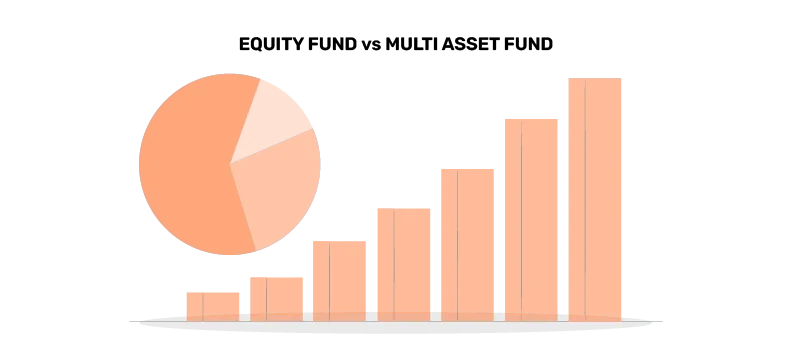Equity funds vs. multi asset fund: Understanding the difference


Equity funds and multi asset funds are two common types of mutual funds. While both offer the potential for long-term capital appreciation, there are some key differences between these fund categories that investors should understand. Read on to learn more.
- Table of contents
- What is an equity fund?
- What is a multi asset fund?
- Difference between equity and mutual asset funds
- How to choose between equity funds and multi asset funds
- Taxation Rules of Equity Mutual Funds
- Taxation Rules of Multi-Asset Allocation Funds
What is an equity fund?
An equity fund, also known as a stock fund, primarily invests in shares of companies. The goal of an equity fund is to provide growth potential by generating returns from stock price appreciation and dividends. Some examples of equity fund categories include large cap, mid cap, small cap, sectoral, thematic, dividend yield, and tax saving funds.
Equity funds aim to beat broader stock market returns over the long run. However, they are exposed to volatility and risks associated with the stock market. Hence, the return potential from equity funds is not fixed - it depends on the performance of the fund's underlying stocks.
What is a multi asset fund?
A multi asset fund is a hybrid fund that invests across various asset classes like equities, debt, gold, global stocks, REITs, InvITs etc. Multi asset allocation funds are a type of multi asset fund that actively changes allocation between equity, debt, gold, and other assets depending on the fund manager’s market outlook. Multi-asset funds invest in at least 3 asset classes. The portfolio is actively managed to adjust the allocation between different asset classes depending on prevailing market conditions and opportunities.
The aim of multi asset funds is to optimise risk-adjusted returns. By investing across assets with varying risk profiles, these funds aim to mitigate volatility compared to pure equity funds. The diversification helps to potentially limit downside risk during market declines.
Difference between equity and mutual asset funds
While equity and multi asset funds have some common characteristics, the difference between equity fund and multi asset fund lies in aspects as mentioned below.
Portfolio construction
- Equity funds have at least 65% allocation to equities by mandate, with the balance in debt and cash.
- Multi asset funds are mandated by SEBI to invest in at least 3 asset classes with a minimum allocation of at least 10% in each asset class.
Diversification
- Equity funds have concentrated exposure to a single asset class, i.e., stocks.
- Multi asset funds provide diversification across various asset classes to balance the risk-return profile.
Risk-return profile
- Equity funds carry relatively higher risk as they are vulnerable to stock market volatility. But they also offer a higher return potential over the long run.
- Multi asset funds exhibit relatively lower risk as asset allocation is actively managed. But returns may lag pure equity funds in bull markets.
Management style
- Amongst equity funds, passive equity funds follow a buy-and-hold approach with minimal trading.
- Multi asset funds require active management of asset allocation based on market valuation and momentum.
Suitability
- Equity funds may be suitable for investors with a higher risk appetite and ability to withstand volatility.
- Multi asset funds are more appropriate for conservative investors looking for relatively stable growth across varying market cycles.
When comparing an equity fund and multi asset fund, the key differences lie in portfolio construction, diversification, risk-return profile, and suitability for investors.
How to choose between equity funds and multi asset funds
Choosing between equity funds and multi-asset funds depends on factors like risk tolerance, investment goals, and time horizon.
Equity Funds
Pros: Higher growth potential and reasonable returns.
Cons: High volatility and risk due to market fluctuations.
Suitable for: High-risk tolerance investors with a long-term horizon seeking aggressive growth.
Multi-Asset Funds
Pros: Diversified approach reduces overall portfolio risk. Helps mitigate risks of market downturns with a balance between growth and stability.
Cons: May offer lower returns than equity funds, especially in strong bull markets.
Suitable For: Moderate risk tolerance investors seeking a diversified portfolio with professional management.
Taxation Rules of equity mutual funds
For equity mutual funds, gains from units held for up to 1 year (12 months) before selling are classified as Short-Term Capital Gains (STCG) and are taxed at a rate of 15%. If the units are held for more than 1 year, the gains are subject to Long-Term Capital Gains (LTCG) tax. The LTCG tax on equity mutual funds is 12.5% on gains exceeding Rs.1.5 lakh in a financial year.
Taxation Rules of Multi-Asset Allocation Funds
Multi-asset funds that invest 65% or more in equities, with the rest in fixed income and gold, are taxed as equity funds. This means that if these funds are held for over a year, they are subject to a 12.5% long-term capital gains tax (LTCG).
Conclusion
Equity funds are concentrated stock investments ideal for potentially building long term capital and beating inflation. But be prepared for significant volatility. Multi asset funds provide greater diversification and relatively lower risk through active asset allocation. But returns may trail dedicated equity funds over the long run. Choose equity funds if you have a long investment horizon and high-risk tolerance. Opt for multi asset funds if you want balanced exposure across assets. Understanding the core differences between an equity fund vs multi asset fund can help investors select the category aligned to their investment objectives and risk appetite. Using a mutual fund compound interest calculator can also help investors visualize how their investments can potentially grow over time, helping them make well-informed decisions.
FAQs:
Which is better - equity funds or multi asset funds?
There is no clear winner. The choice depends on one's risk appetite, return expectation, and investment horizon. Equity funds are tax-efficient and offer higher return potential over a 7-10 year horizon. Multi asset funds provide greater diversification and relative stability.
How often does a multi asset fund change its allocation?
Multi asset funds dynamically change their asset allocation in response to market movements. The allocation can change significantly within a short period based on the fund manager's outlook.
Which fund is riskier: equity funds or multi-asset funds?
Equity funds are generally riskier than multi-asset funds due to their concentrated exposure to stocks, leading to higher volatility. Multi-asset funds offer diversification across asset classes, helping to reduce risk and mitigate market fluctuations. However, risk levels vary depending on each fund's composition and objectives.
How does the return potential compare between equity and multi-asset funds?
Equity funds have higher return potential over the long term due to their focus on stocks, but they also come with increased risk. Multi-asset funds aim to balance risk and return by diversifying across asset classes, potentially offering more stable returns but lower growth during bull markets.
Do equity funds and multi-asset funds have the same tax implications?
No. The tax implications of equity funds and multi-asset funds depend on equity exposure and holding period. Equity funds are taxed at 12.5% LTCG (over Rs 1.25 lakh) or 20% STCG, while multi-asset funds are taxed based on their equity exposure.
Are multi-asset funds suitable for short-term investments?
Multi-asset funds are generally not suitable for short-term investments due to their long-term focus and potential for short-term volatility. They balance risk and return over extended periods, which can result in fluctuations and potential losses in the short term. For short-term options, liquid or money market funds are more appropriate.
Can I invest in both equity and multi-asset funds simultaneously?
Yes, investing in both equity and multi-asset funds can be an effective strategy for diversifying your portfolio. This approach allows you to balance higher growth potential from equity funds with the risk mitigation and stability offered by multi-asset funds.
What factors should I consider when choosing between equity funds and multi-asset funds?
When choosing between equity and multi-asset funds, consider your risk tolerance, investment horizon, goals, diversification needs, financial situation, experience, and tax implications. Equity funds suit those seeking higher growth and willing to take on risk, while multi-asset funds offer diversification and lower risk, ideal for balanced portfolios.
Mutual Fund investments are subject to market risks, read all scheme related documents carefully.
This document should not be treated as endorsement of the views/opinions or as investment advice. This document should not be construed as a research report or a recommendation to buy or sell any security. This document is for information purpose only and should not be construed as a promise on minimum returns or safeguard of capital. This document alone is not sufficient and should not be used for the development or implementation of an investment strategy. The recipient should note and understand that the information provided above may not contain all the material aspects relevant for making an investment decision. Investors are advised to consult their own investment advisor before making any investment decision in light of their risk appetite, investment goals and horizon. This information is subject to change without any prior notice.
Mutual Fund Investments are subject to market risks, read all scheme related documents carefully.
This document should not be treated as endorsement of the views / opinions or as an investment advice. This document should not be construed as a research report or a recommendation to buy or sell any security. This document is for information purpose only and should not be construed as a promise on minimum returns or safeguard of capital. This document alone is not sufficient and should not be used for the development or implementation of an investment strategy. The recipient should note and understand that the information provided above may not contain all the material aspects relevant for making an investment decision. Investors are advised to consult their own investment advisor before making any investment decision in light of their risk appetite, investment goals and horizon. This information is subject to change without any prior notice.